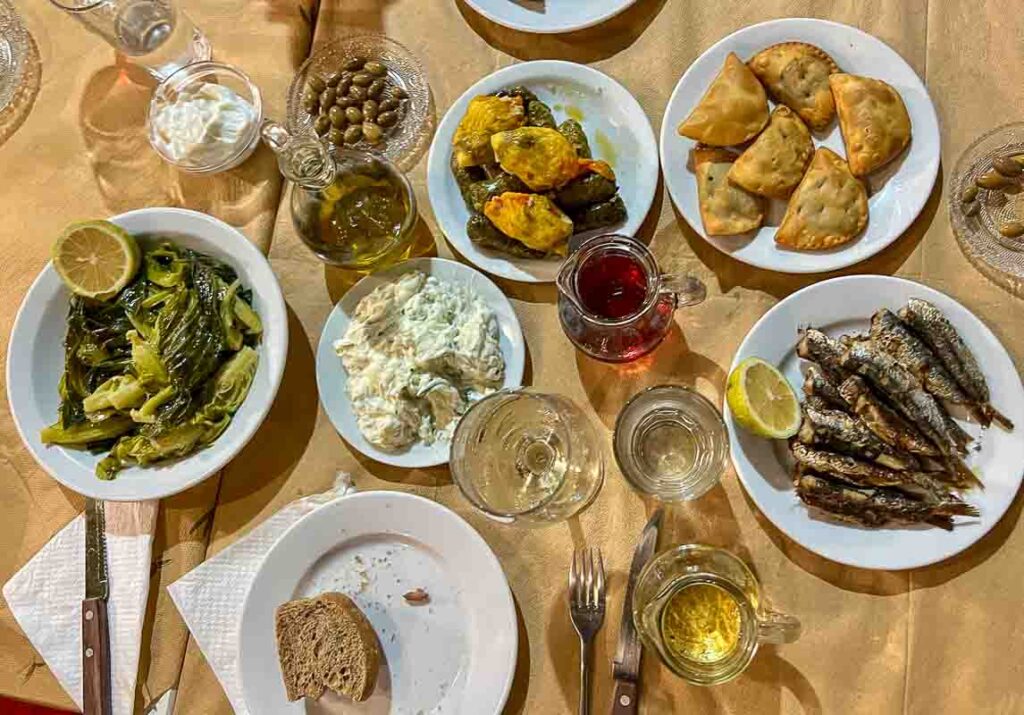
Crete, the largest of the Greek islands, is renowned for its rich culinary tradition, which is deeply intertwined with its history and culture. The island’s cuisine is based on fresh, local ingredients and simple yet flavorful preparations. Here’s an in-depth look at the food and wine of Crete.
Traditional Dishes
1. Dakos
- Description: A traditional Cretan salad made with barley rusks, topped with chopped tomatoes, crumbled feta or mizithra cheese, olives, and drizzled with olive oil.
- Cooking Method: No cooking required; the barley rusks are softened slightly with water or olive oil before topping.
- Where to Try: Available in most Cretan tavernas as a starter or light meal.
2. Kalitsounia
- Description: Small Cretan pies that can be either sweet or savory, filled with cheese, herbs, or honey.
- Cooking Method: The dough is filled with ingredients and then baked or fried.
- Where to Try: Commonly found in bakeries and as appetizers in restaurants.
3. Chaniotiko Boureki
- Description: A traditional dish from Chania, made with layers of zucchini, potatoes, and cheese, often flavored with mint.
- Cooking Method: Baked until the vegetables are tender and the cheese is melted and golden.
- Where to Try: Particularly popular in Chania but available across Crete.
4. Stamnagathi
- Description: Wild greens often served boiled and drizzled with olive oil and lemon juice.
- Cooking Method: Boiled briefly to retain their slight bitterness and nutritional value.
- Where to Try: Served as a side dish in many Cretan meals.
5. Gamopilafo
- Description: A traditional rice dish, often served at weddings, made with lamb or goat meat broth and a touch of lemon.
- Cooking Method: The rice is cooked in a rich broth until creamy, similar to a risotto.
- Where to Try: Typically prepared for special occasions, but some restaurants offer it.
6. Sfakianes Pites
- Description: Thin, round pies from Sfakia, filled with mizithra cheese and sometimes drizzled with honey.
- Cooking Method: Cooked on a griddle until golden brown.
- Where to Try: Best experienced in the region of Sfakia.
Local Specialties
1. Cretan Cheese
- Types: Graviera (a hard cheese), Myzithra (a soft, whey cheese), and Anthotyro (a fresh cheese).
- Where to Try: Available in local markets, cheese shops, and as part of many traditional dishes.
2. Cretan Honey
- Description: Known for its high quality and unique flavor, often derived from thyme or pine.
- Where to Try: Can be found at local markets, farms, and included in many desserts and breakfast items.
3. Olive Oil
- Description: Crete produces some of the finest olive oil in the world, a staple in Cretan cuisine.
- Where to Try: Used extensively in cooking and available for purchase at local markets and farms.
Local Beverages
1. Raki (Tsikoudia)
- Description: A traditional Cretan spirit distilled from grape pomace, often served as a welcome drink or after a meal.
- Where to Try: Offered in most restaurants and bars, and often homemade by locals.
2. Wine
- Varieties: Crete has a long history of winemaking with indigenous grape varieties such as Vidiano (white), Vilana (white), and Liatiko (red).
- Where to Try: Local wineries, wine bars, and restaurants.
Wine Regions
1. Heraklion
- Characteristics: Known for producing both red and white wines, with wineries offering tours and tastings.
- Notable Wines: The wines here often have rich, fruity profiles with balanced acidity.
2. Chania
- Characteristics: This region is known for its diverse wine offerings and beautiful vineyard landscapes.
- Notable Wines: Wines from this area often have a distinct mineral quality due to the region’s soil.
3. Lasithi
- Characteristics: Produces aromatic white wines and robust red wines.
- Notable Wines: Wines from Lasithi are noted for their complexity and depth of flavor.
Culinary Experience
1. Taverna Dining
- Experience: Traditional Cretan tavernas offer a warm and authentic dining experience. Meals are often shared, with a focus on fresh, seasonal ingredients.
- Popular Dishes: Expect to find a variety of meze (small dishes), grilled meats, seafood, and hearty salads.
2. Farm-to-Table
- Experience: Some establishments offer farm-to-table experiences, where visitors can tour farms and vineyards before enjoying meals made from the produce.
- Highlights: These experiences often include tastings of olive oil, cheese, honey, and wine, providing a deeper connection to the island’s agricultural heritage.
3. Cooking Classes
- Experience: Participating in a cooking class allows visitors to learn traditional Cretan recipes and cooking techniques.
- Highlights: Classes often include a visit to a local market to source ingredients, followed by hands-on preparation and cooking.
Conclusion
Crete’s food and wine are a testament to the island’s rich history and vibrant culture. The cuisine, deeply rooted in tradition, emphasizes the use of fresh, local ingredients to create dishes that are both simple and extraordinarily flavorful. Whether you’re enjoying a rustic meal in a taverna, exploring local wines at a vineyard, or indulging in the island’s renowned cheeses and olive oil, Crete offers a culinary experience that is as diverse and captivating as its landscape.